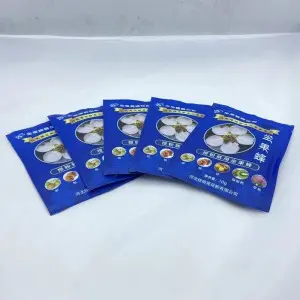Peach pollen is a highly nutritious and beneficial product derived from the delicate pollen grains of peach blossoms. Known for its rich content of vitamins, minerals, amino acids, and antioxidants, peach pollen has long been celebrated in traditional medicine for its potential health-boosting properties. This natural product is often used to support immune function, improve energy levels, and enhance overall well-being. Packed with bioactive compounds, peach pollen is also believed to aid in reducing inflammation, promoting digestive health, and supporting skin vitality. The unique composition of peach pollen makes it a valuable supplement for those seeking natural remedies for common health concerns. As a plant-based product, peach pollen is suitable for various dietary preferences, offering an eco-friendly and sustainable option for boosting nutrition. Whether consumed as a powder, in capsules, or incorporated into beverages, peach pollen can be easily added to daily routines. With its delicate floral aroma and a wealth of health benefits, peach pollen is rapidly gaining recognition as a powerful superfood in the wellness industry.
Peach Pollen and Pollinator Health: A Symbiotic Relationship
Peach pollen plays a vital role in the delicate ecosystem of pollination, particularly in peach orchards, where the health of pollinators such as bees is closely intertwined with the flowering process. As a crucial food source for bees and other pollinating insects, peach pollen contributes to their nutrition, enabling them to perform their essential role in transferring pollen from flower to flower. This transfer is what allows peach trees to produce fruit, making pollinators indispensable to the success of the crop.
The symbiotic relationship between peach pollen and pollinators benefits both parties. Bees collect peach pollen to feed their colonies, especially during early spring when other food sources may be scarce. In return, as they forage for nectar, bees inadvertently collect and carry peach pollen to other flowers, facilitating cross-pollination and enhancing fruit set. Healthy pollinator populations are essential for ensuring that peach trees are effectively pollinated, resulting in higher yields and better-quality fruit.
However, the health of pollinators is increasingly threatened by factors such as pesticide exposure, habitat loss, and climate change. This makes the presence of high-quality peach pollen even more crucial. Providing an abundant, nutritious source of pollen helps support pollinator health and resilience. Furthermore, by fostering a strong relationship between peach pollen and pollinators, growers can help maintain sustainable, environmentally friendly farming practices.
Peach Pollen Collection Techniques for Optimized Pollination
Efficient peach pollen collection is essential for ensuring effective pollination in peach orchards, especially when natural pollinators like bees are in limited supply or during off-peak pollination periods. By using advanced pollen collection techniques, growers can optimize pollination, enhance fruit set, and increase yields, ensuring a successful harvest.
One commonly used technique for collecting peach pollen involves the use of specially designed pollen traps placed on the blossoms. These traps are typically made of fine mesh or sticky surfaces that capture the pollen as it falls from the flowers. The trapped pollen can then be collected, cleaned, and stored for future use in controlled pollination efforts. This method is highly effective when bees or other natural pollinators are less active, as it allows for the strategic deployment of pollen in specific areas of the orchard.
Another method involves the mechanical shaking of peach branches to release the pollen. This is often done with a portable device that mimics natural wind or insect activity, shaking the flowers to release their pollen into a collection container. While this technique requires careful handling to avoid damage to the blossoms, it can yield large amounts of pollen in a short time.
Once collected, peach pollen must be handled with care to maintain its viability. Pollen can be stored in a cool, dry environment, often in a sealed container, to prevent moisture and heat from degrading its quality. In some cases, growers may choose to freeze pollen to extend its shelf life.

